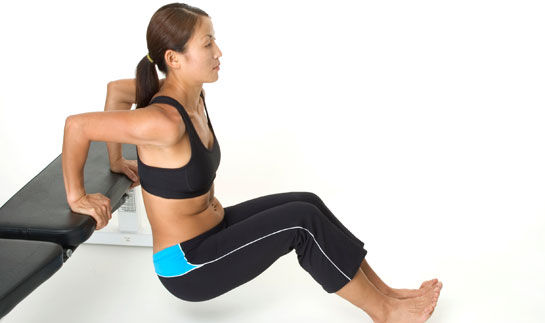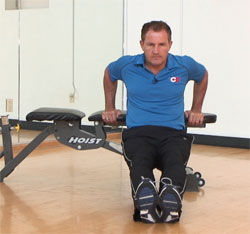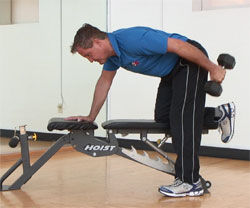
By Brittany Boehler, B.S., John P. Porcari, Ph.D., Dennis Kline, M.S., C. Russell Hendrix, Ph.D., and Carl Foster, Ph.D., with Mark Anders
Women from all walks of life struggle to avoid the dreaded flabby, jiggly arms—and they often turn to personal trainers and fitness pros for help. “Guys always want to get rid of their bellies, while women always seem to want to tone their triceps,” says John Porcari, Ph.D., an exercise physiologist with the University of Wisconsin and former personal trainer. But as with most clients, their time is constantly being gobbled up by work and family obligations, leaving very little extra time for regular exercise. They want results—and fast! With that in mind, the American Council on Exercise, the nation’s Workout Watchdog, sponsored comprehensive research to determine which exercises are most effective—and efficient—for targeting the triceps. Armed with this new research, you'll be able to better guide your clients in their efforts to tone and strengthen their triceps.
The Study
To determine the efficacy of the eight most common triceps exercises, ACE enlisted a team of exercise scientists from the University of Wisconsin/La Crosse Exercise and Health Program. Led by John Porcari, Ph.D., and Brittany Boehler, B.S., the research team recruited 15 healthy female subjects, ages 20 to 24, from the local La Crosse community. All of the test subjects had previous weight-training experience to ensure proper exercise technique and to limit the potential for injuries.
Prior to the study, test subjects were required to abstain from weight training with their arms for 48 hours to reduce fatigue. On the initial day of testing, researchers determined each subject’s one-repetition max (1 RM) for each of the following exercises: triceps kickbacks, overhead triceps extensions, bar push-downs, rope push-downs, closed-grip bench press and lying barbell triceps extensions. Dips and triangle push-ups were excluded during this first round since both of those exercises use body weight as resistance instead of weights, making the 1RM test inappropriate.
Once the 1 RM was determined for each subject, the women returned for a second day of testing. Researchers applied two sets of electromyographic (EMG) electrodes on the long and lateral heads of each subject’s triceps brachii (the back of the upper arm) to record real-time muscle activity. To set a baseline for EMG comparison, subjects first performed a pair of maximal voluntary isometric contractions (MVIC) for the triceps muscle. They then completed one set of seven repetitions of each of the eight different exercises. The exercises were completed in random order with a five-minute rest between each exercise to ensure proper muscle recovery. Subjects lifted 70 percent of their previously determined 1 RM for the bulk of exercises; body weight was used for the dips and triangle push-ups. The EMG data from each exercise was recorded and presented as a percentage of the highest EMG readings obtained during the two MVIC trials.
The Results
Upon completion of the testing, the EMG data were crunched and processed. Porcari and his team reported that muscle activity was greatest while subjects performed the triangle push-ups, which made it the gold standard of triceps exercises.
“All across the board, the triangle push-ups elicited the most muscle activity in our subjects,” says researcher Brittany Boehler, B.S. “The dips and triceps kickbacks weren’t that far behind either. Essentially, all three exercises could be used interchangeably.”
Because the triangle push-ups elicited the highest average EMG activity, data for the remaining seven exercises were then represented as a percentage of the EMG activity of the triangle push-up (Table 1).
|
Table 1
Average EMG of the Entire Movement (Concentric and Eccentric)
|
Triceps Exercise
|
Combined Means |
Long Head |
Lateral Head |
| Triangle Push-up |
100 |
100 |
100 |
Kickbacks
|
87 ± 26.58 |
88 ± 33.0 |
87 ± 23.7 |
Dips
|
87 ± 19.87 |
87 ± 21.3 |
88 ± 20.0 |
| Overhead Triceps Extensions |
76 ± 16.09 * |
81 ± 21.4 * |
72 ± 16.5 * |
| Rope Pushdowns |
74 ± 22.64 * |
81 ± 32.3 * |
67 ± 15.7 *† |
| Bar Pushdowns |
67 ± 20.48 * |
75 ± 29.3 * |
59 ± 14.3 *† |
| Lying Barbell Triceps Extensions |
62 ± 16.25 * |
70 ± 20.9 * |
55 ± 14.1 *† |
| Closed-grip Bench Press |
62 ± 15.88 * |
61 ± 16.9 * |
63 ± 15.5 * |
* Significantly lower than the Triangle Push-up (p < 0.05)
† Significantly lower than the Long Head (p < 0.05)
The Bottom Line
You can quickly and effectively tone and strengthen the triceps using triangle push-ups, triceps kickbacks and dips.
Why are those exercises so much more effective than the others tested? Porcari says it’s because your body weight is used in the push-ups and dips, and because it’s easier to “cheat” (using momentum to more easily complete reps) while doing the other exercises, specifically the bar push-downs and rope push-downs.
“Many women are concerned they don’t have time to get to the gym or they don’t have the necessary exercise equipment at home to get fit,” says Boehler. “But this research essentially eliminates those excuses.”
As far as equipment goes, the über-effective triangle push-ups require zero equipment, while all you need to do dips is a sturdy household chair. The triceps kickbacks are best performed with dumbbells, but any sort of weight would work, such as a jug of water or canned food. “Most people’s triceps are relatively weak, especially if you isolate them,” notes Porcari. “If you’re doing the kickbacks correctly, it doesn’t really take a whole lot of weight to get a good workout.” (Check out the exercise descriptions and video demonstrations, below.)
And the exercises don’t require a lot of time either, Boehler says. “I think the take-home message is that if somebody really wants to work their triceps in a short amount of time, they’ll get the most bang for the buck from these three exercises.”
THE TOP THREE
TRIANGLE PUSH-UPS
The triangle push-up derives its name from the placement of the hands during the exercise. Unlike a traditional push-up, with hands positioned beneath the shoulders, the triangle push-up involves placing the thumbs and forefingers together to form a triangle position.

Stiffen your torso by contracting your core/abdominal, gluteal and quadriceps muscles and align your head with your spine. Place your feet together with your ankles dorsiflexed (toes pointed toward your shins). Due to the challenging nature of this position, however, you may want to start with a modified version of the exercise by placing your knees on the floor.
For the downward phase, slowly lower your body toward the floor while maintaining a rigid torso and keeping your head aligned with your spine. Do not allow your low back to sag or your hips to hike upward during this downward phase. Continue to lower yourself until your chest or chin touches the mat/floor.
For the upward phase, press up through your arms while maintaining a rigid torso and keeping your head aligned with your spine. For extra strength, think about pushing the floor away from you. Do not allow your low back to sag or your hips to hike upward. Continue pressing until the arms are fully extended at the elbows.
DIPS

For the study, dips were performed using a low bench, but just about any sturdy chair or ledge can be used. Begin by placing your hands on either side of your hips so your palms are resting on the bench and your fingers are hanging over the edge. With your feet together, extend your legs out in front of you.
Carefully move your buttocks off the bench, while leaving your hands in place. Lower your hips toward the floor until your upper arms are parallel to the floor. Push back up using your hands rather than your legs, and repeat.
TRICEPS KICKBACKS
Proper form in performing the triceps kickback exercise is important not only for targeting triceps activity, but also for safety reasons to prevent additional loading on your spine.

Begin by holding a dumbbell in your left hand and assume a split-stance position. Place your right leg forward, but keep your weight evenly distributed through the heels of both feet. Stiffen your torso by contracting your abdominal and core muscles. Place your right hand on your right thigh or knee and slowly lean forward, transferring most of your upper-extremity body weight onto that right side. Depress and retract your left scapula—pull your shoulder down and back—and maintain this position throughout the exercise. Your head should be aligned with your spine.
Position your left upper arm parallel to, and close to, your torso. Bend your elbow to 90 degrees or at least to a point where your forearm hangs vertical to the floor.
For the upward phase, exhale and slowly extend (straighten) your elbow by contracting your triceps muscles until your elbow is fully extended. Your upper arm should remain stationary next to your torso and not raised during the movement. Avoid any arching or sagging in your low back or any rotation in your torso.
For the downward phase, inhale and slowly return your arm to your starting position, without changing your torso position. Keep your upper arm parallel and close to your torso.
This study was funded solely by the American Council on Exercise (ACE).
Worried about the safety of dips? ACE provided answers to your comments and questions. Read the Follow-up Q and A: Dangerous Dips.

MARK ANDERS is an award-winning journalist who has covered a wide range of topics from rock star profiles to surfing river waves in Africa. His work has been published in more than 20 different magazines and books.